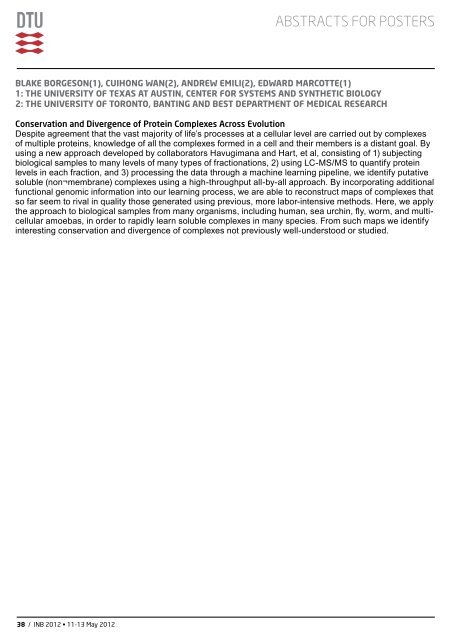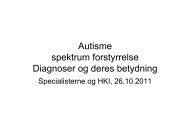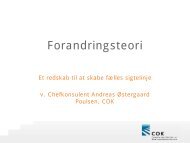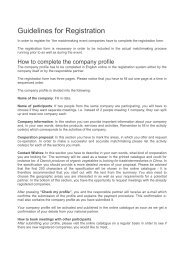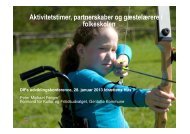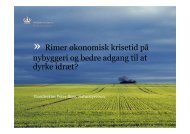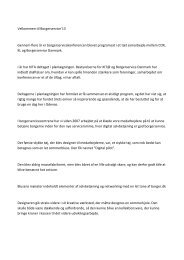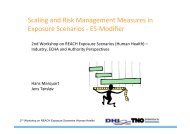11-13 May 2012 Helsingør - Denmark www.networkbio.org
11-13 May 2012 Helsingør - Denmark www.networkbio.org
11-13 May 2012 Helsingør - Denmark www.networkbio.org
Create successful ePaper yourself
Turn your PDF publications into a flip-book with our unique Google optimized e-Paper software.
BLAKE BORGESON(1), CUIhONG WAN(2), ANDREW EMILI(2), EDWARD MARCOTTE(1)<br />
1: ThE UNIVERSITY Of TExAS AT AUSTIN, CENTER fOR SYSTEMS AND SYNThETIC BIOLOGY<br />
2: ThE UNIVERSITY Of TORONTO, BANTING AND BEST DEPARTMENT Of MEDICAL RESEARCh<br />
Conservation and Divergence of Protein Complexes Across Evolution<br />
Despite agreement that the vast majority of life’s processes at a cellular level are carried out by complexes<br />
of multiple proteins, knowledge of all the complexes formed in a cell and their members is a distant goal. By<br />
using a new approach developed by collaborators Havugimana and Hart, et al, consisting of 1) subjecting<br />
biological samples to many levels of many types of fractionations, 2) using LC-MS/MS to quantify protein<br />
levels in each fraction, and 3) processing the data through a machine learning pipeline, we identify putative<br />
soluble (non¬membrane) complexes using a high-throughput all-by-all approach. By incorporating additional<br />
functional genomic information into our learning process, we are able to reconstruct maps of complexes that<br />
so far seem to rival in quality those generated using previous, more labor-intensive methods. Here, we apply<br />
the approach to biological samples from many <strong>org</strong>anisms, including human, sea urchin, fly, worm, and multicellular<br />
amoebas, in order to rapidly learn soluble complexes in many species. From such maps we identify<br />
interesting conservation and divergence of complexes not previously well-understood or studied.<br />
abStractS For PoSterS abStractS For PoSterS<br />
ChRISTOPhER A. BARNES, ALESSIO MAIOLICA, RUEDI AEBERSOLD<br />
INSTITUTE Of MOLECULAR SYSTEMS BIOLOGY, ETh züRICh, SWITzERLAND<br />
A Global Kinase-Substrate Network in Yeast Mapped Using In Vitro Phosphorylation and Phosphoproteomics<br />
Kinase inhibitor drugs have been a major focus in the pharmaceuticals industry over the past decade.<br />
Despite extensive development of these inhibitors, their effectiveness has been limited. It is thought that<br />
the difficulties associated with kinase inhibitor drug effectiveness relates to network compensation events<br />
in the cell that allow other kinases to replace the lost function of the inhibited enzyme. To date, it has been<br />
difficult to link kinases to substrates at the amino acid level with methodologies suitable to creating a global<br />
kinase-substrate wiring diagram. Identifying direct kinase-substrate relationships for each kinase could help<br />
researchers to design pharmaceutical solutions that take into account network compensations. The aim<br />
of this project is to identify kinase-substrate relationships in yeast for all of the kinases in S. cerevisiae. In<br />
previous studies in the lab1, experiments were performed where kinases were sequentially deleted, but the<br />
identification of direct kinase-substrate relationships with these deletion studies proved difficult. Here, we<br />
have taken a large library of the most regulated phosphosites from these deletion experiments and synthesized<br />
unphosphorylated peptides suitable for in vitro phosphorylation followed by LC-MS/MS identification of<br />
the phosphorylated product peptides. We use endogenously expressed immunopurified kinases followed by<br />
a phosphopeptide enrichment step prior to mass spectrometry analysis. Our phosphorylation assays have<br />
shown good specificity in vitro as evidenced by the identification of specific known consensus motifs and<br />
we have begun to identify subfamily redundancies in the substrate networks as this yeast phosphorylation<br />
wiring diagram is beginning to emerge.<br />
References:<br />
1. Bodenmiller et al. Sci. Signal. 3, rs4 (2010).<br />
38 / INB <strong>2012</strong> • <strong>11</strong>-<strong>13</strong> <strong>May</strong> <strong>2012</strong> <strong>www</strong>.<strong>networkbio</strong>.<strong>org</strong> / 39


